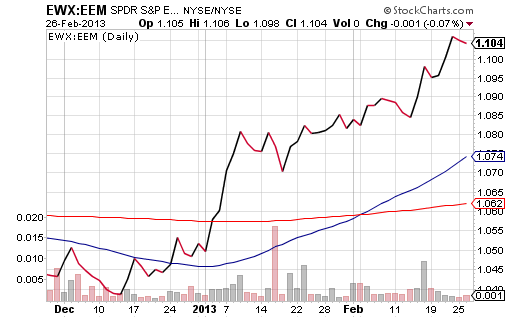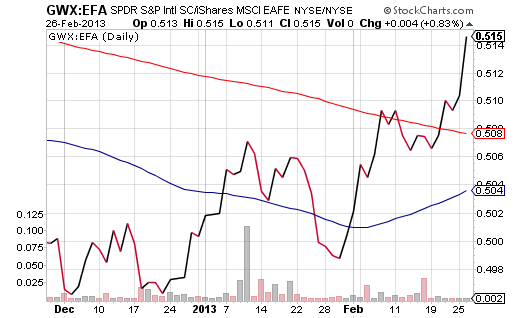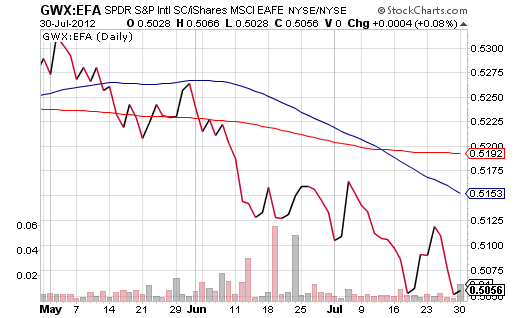Over the last 3 months, U.S. small cap stocks as well as foreign and emerging market small caps logged spectacular profits. Moreover, they beat the pants off of larger-cap competition.
Consider the recent highs in various price ratios. For instance, SPDR S&P Emerging Market Small Cap (EWX):iShares MSCI Emerging Markets (EEM) demonstrates increasing relative strength for smaller emergers.
The song remains the same for S&P International Small Cap (GWX):iShares MSCI EAFE (EFA)…
And for the iShares Russell 2000 (IWM): SPDR S&P 500 Trust (SPY).
In brief, investors who embraced smaller companies over the last 3 months witnessed greater portfolio growth than those who did not. Yet there is evidence to suggest that the trend may not be sustainable.
For example, in late April of 2012, Spain’s borrowing costs began to soar on speculation about the solvency of the country’s banks. The euro-zone debt crisis degenerated over the next 10 weeks, until the President of the European Central Bank (ECB), Mario Draghi, assured the world that it would do everything and anything to protect the euro. During that harrowing period, market forces punished international small-caps in GWX far worse than they had larger companies in EFA.
Granted, there’s a difference between the Italian citizenry rejecting austerity than a fear-provoking run on European banks. That said, borrowing costs for Italy skyrocketed after the recent election produced a parliamentary government without sufficient alliances or votes to govern. It follows that any additional increases in the costs for Italy or Spain to borrow might lead to a similar rejection of riskier small-caps.
U.S. domestic small-caps are no less immune to euro-zone troubles. While the S&P 500 SPDR Trust (SPY) shed 1.9% in Monday’s beating, iShares Russell 2000 (IWM) fell 2.2%. That 30 basis point difference may be typical for a broad-based shellacking. However, on Tuesday’s bounce (2/26), SPY climbed 0.7% whereas IWM only rose 0.4%. Losing ground when markets move in either direction is somewhat ominous.
In my estimation, small caps are likely to underperform large caps over the next 3 months. Although the Federal Reserve may prevent any corrective activity from getting out of hand, anti-government protests in Europe coupled with a stalemate over automatic spending cuts in the United States would suggest a more defensive posture.
If you are only intrigued by minor tweaks, you might shift from small-cap dominated IWM to iShares Mid Cap Value (IJJ) or Vanguard Value (VTV). If you want to lower your volatility with a broader brush-stroke, PowerShares S&P 500 Low Volatility (SPLV) might serve as your replacement.
Disclosure: Gary Gordon, MS, CFP is the president of Pacific Park Financial, Inc., a Registered Investment Adviser with the SEC. Gary Gordon, Pacific Park Financial, Inc, and/or its clients may hold positions in the ETFs, mutual funds, and/or any investment asset mentioned above. The commentary does not constitute individualized investment advice. The opinions offered herein are not personalized recommendations to buy, sell or hold securities. At times, issuers of exchange-traded products compensate Pacific Park Financial, Inc. or its subsidiaries for advertising at the ETF Expert web site. ETF Expert content is created independently of any advertising relationships.
- English (UK)
- English (India)
- English (Canada)
- English (Australia)
- English (South Africa)
- English (Philippines)
- English (Nigeria)
- Deutsch
- Español (España)
- Español (México)
- Français
- Italiano
- Nederlands
- Português (Portugal)
- Polski
- Português (Brasil)
- Русский
- Türkçe
- العربية
- Ελληνικά
- Svenska
- Suomi
- עברית
- 日本語
- 한국어
- 简体中文
- 繁體中文
- Bahasa Indonesia
- Bahasa Melayu
- ไทย
- Tiếng Việt
- हिंदी
Are Small Cap ETFs Still Beautiful?
Published 02/27/2013, 02:51 AM
Updated 03/09/2019, 08:30 AM
Are Small Cap ETFs Still Beautiful?
3rd party Ad. Not an offer or recommendation by Investing.com. See disclosure here or
remove ads
.
Latest comments
Install Our App
Risk Disclosure: Trading in financial instruments and/or cryptocurrencies involves high risks including the risk of losing some, or all, of your investment amount, and may not be suitable for all investors. Prices of cryptocurrencies are extremely volatile and may be affected by external factors such as financial, regulatory or political events. Trading on margin increases the financial risks.
Before deciding to trade in financial instrument or cryptocurrencies you should be fully informed of the risks and costs associated with trading the financial markets, carefully consider your investment objectives, level of experience, and risk appetite, and seek professional advice where needed.
Fusion Media would like to remind you that the data contained in this website is not necessarily real-time nor accurate. The data and prices on the website are not necessarily provided by any market or exchange, but may be provided by market makers, and so prices may not be accurate and may differ from the actual price at any given market, meaning prices are indicative and not appropriate for trading purposes. Fusion Media and any provider of the data contained in this website will not accept liability for any loss or damage as a result of your trading, or your reliance on the information contained within this website.
It is prohibited to use, store, reproduce, display, modify, transmit or distribute the data contained in this website without the explicit prior written permission of Fusion Media and/or the data provider. All intellectual property rights are reserved by the providers and/or the exchange providing the data contained in this website.
Fusion Media may be compensated by the advertisers that appear on the website, based on your interaction with the advertisements or advertisers.
Before deciding to trade in financial instrument or cryptocurrencies you should be fully informed of the risks and costs associated with trading the financial markets, carefully consider your investment objectives, level of experience, and risk appetite, and seek professional advice where needed.
Fusion Media would like to remind you that the data contained in this website is not necessarily real-time nor accurate. The data and prices on the website are not necessarily provided by any market or exchange, but may be provided by market makers, and so prices may not be accurate and may differ from the actual price at any given market, meaning prices are indicative and not appropriate for trading purposes. Fusion Media and any provider of the data contained in this website will not accept liability for any loss or damage as a result of your trading, or your reliance on the information contained within this website.
It is prohibited to use, store, reproduce, display, modify, transmit or distribute the data contained in this website without the explicit prior written permission of Fusion Media and/or the data provider. All intellectual property rights are reserved by the providers and/or the exchange providing the data contained in this website.
Fusion Media may be compensated by the advertisers that appear on the website, based on your interaction with the advertisements or advertisers.
© 2007-2024 - Fusion Media Limited. All Rights Reserved.
